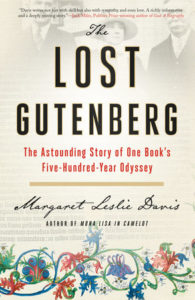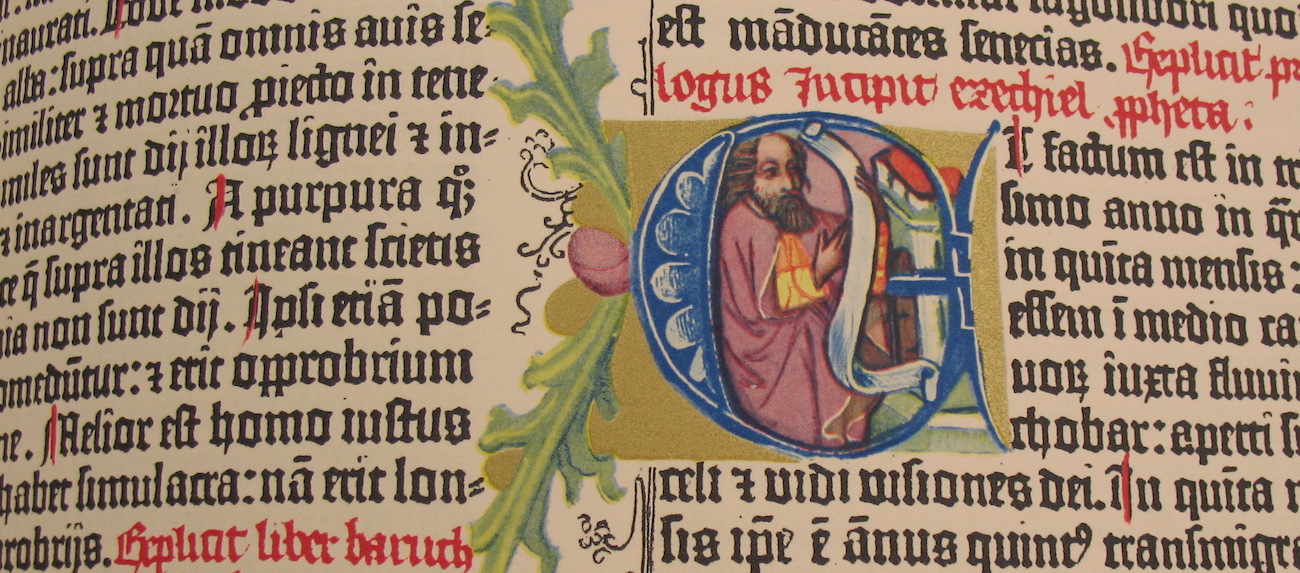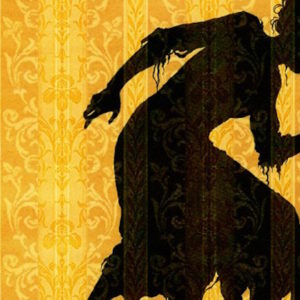A wooden box containing one of the most valuable books in the world arrives in Los Angeles on October 14, 1950, with little more fanfare—or security—than a Sears catalog. Code-named “the commode,” it was flown from London via regular parcel post, and while it is being delivered locally by Tice and Lynch, a high-end customs broker and shipping company, its agents have no idea what they are carrying and take no special precautions.
The widow of one of the wealthiest men in America, Estelle Betzold Doheny is among a handful of women who collect rare books, and she has amassed one of the most spectacular libraries in the West. Acquisition of the Gutenberg Bible, universally acknowledged as the most important of all printed books, will push her into the ranks of the greatest book collectors of the era. Its arrival is the culmination of a 40-year hunt, and she treasures the moment as much as the treasure.
Estelle’s pursuit of a Gutenberg began in 1911, when she was a wasp-waisted, dark-haired beauty, half of a firebrand couple reshaping the American West with a fortune built from oil. Now 75, she is a soft, matronly figure with waves of gray hair. The auspicious occasion brings a flash of youth to her face, and she is all smiles. But she resists the impulse to rip into the box, leaving it untouched overnight so she can open it with appropriate ceremony the next day.
Estelle has invited one of her confidants, Robert Oliver Schad, the curator of rare books at the Henry E. Huntington Library, to see her purchase, and at noon he arrives with his wife, Frances, and their 18-year-old son, Jasper. Estelle’s secretary, Lucille Miller, escorts the family through the mansion’s Great Hall to the library, and with a sweep of her hand invites the group to sit at the oblong wood table in the center. The Book Room, as Estelle affectionately calls it, is finished in rich redwood and had been her husband’s billiard parlor. Its walls had once featured paintings related to Edward Doheny’s petroleum empire, murals commissioned by the onetime prospector who drilled some of the biggest gushers in the history of oil. Today the room is lined with custom-built shelves for Estelle’s beloved books—her own personal empire, worth as much as Edward’s oil.
Her collection began almost as a lark, sparked by popular lists of books that everyone should own, but now contains nearly 10,000 exceedingly rare volumes available only to the fabulously wealthy and culturally ambitious—gilded illuminated manuscripts glowing with saints and mythical creatures; medieval encyclopedias; and the earliest examples of Western printing, 135 incunabula—books printed before the year 1501. Such seminal works of Western culture as Cicero’s De officiis and Saint Thomas Aquinas’s Summa Theologica rub shoulders with a sumptuous 1477 copy of The Canterbury Tales. This is the million-dollar company the Gutenberg Bible will keep on its shelf.
The two-by-three-foot crate waits at the center of the table, spotlighted by a bronze-and-glass billiard lamp. When Estelle enters the room, accompanied by her companion and nurse, Rose Kelly, the group stands silent. Lucille takes out a pair of scissors and passes it around. Estelle, dressed for the occasion in a pale blue printed silk dress, a gem-studded comb at her right temple, wants everyone to take part, so each person makes a cut in the knotted cord that winds the package.
It’s an emotional occasion for Lucille, too, a slim, long-limbed woman with center-parted, brown hair that curls up around her cheeks. Never without a pencil tucked behind her ear, she has a subdued beauty that’s easy to miss, a pale, symmetrical face hidden behind her glasses. Lucille has been Estelle’s steady partner in the quest for the Gutenberg, party to every promise, hope, and near miss for nearly 20 years. She almost allows herself to smile as she pulls away the box’s coverings and lifts the lid, but then she sees the shabby mess inside. “I could hardly believe my eyes,” she said later. “It just looked like a bundle of old tattered, torn papers. It was the most carelessly wrapped thing I ever saw.” The precious book has been enclosed without padding, wrapped in thin cardboard and then in dark corrugated paper tied with a heavy cord. Lucille mentally chastises the customs officials in New York who had opened the parcel for inspection and then shoved it back in the box “any old way, and tied a string or two here or there and along it came.”
The price of the book when it left the printer’s workshop was believed to be about thirty florins, equivalent to a clerk’s wages for three years.But as she lifts it out of the last of the wrappings, the Bible appears to be fine. For an expert like Robert Schad, there is no mistaking the original 15th-century binding of age-darkened brown calfskin stretched over heavy wood boards. The copy now in Estelle Doheny’s possession is the first issue of the first edition of the first book printed with movable metal type, in near-pristine condition, its pages fresh and clean. The lozenge and floweret patterns stamped into the leather cover are still sharp and firm to the touch. Five raised metal bosses protect the covers, one ornament in the center and one set in an inch from each of the four corners. Two broken leather-edge clasps are the only reminders that this book, which has presented the Living Word for nearly five centuries, has been opened and closed often enough to wear down the heavy straps.
Lucille moves close to her employer, standing on her left and tucking her arm under the spine of the heavy book so that Mrs. Doheny can more easily examine it. Estelle reaches out to touch the fine old leather and slowly lifts the cover and opens the enormous volume. With her gold-framed glasses perched on the edge of her nose, she glides her right hand softly over the edges of the book’s rippling leaves, taking special care not to touch the print. As she turns the crackling pages one by one, she is overcome with quiet joy. Her pursuit of this object of Western invention had begun long ago, during happier days, before her husband was embroiled in scandal. She feels the smoothness of the heavy rag paper under her fingers and strains to focus her gaze on the black Gothic letters, but the Latin text is lost in a cloudy blur and she can’t make out the printed lines. A hemorrhage in one eye and glaucoma in the other have left Estelle almost completely blind at the age of 75.
Still, she knows well what she possesses, and just to be in its presence would be stirring to anyone who understands its significance. The European advancement of printing with movable metal type transformed every aspect of human civilization, and Johann Gutenberg’s execution of the work set a standard that few would match.
As Estelle runs her hands over the book, Schad, a poised man of medium build who’s dressed today in a black suit and tie with a crisp white shirt, points out a few of the qualities that make it unique. Every Gutenberg Bible is somewhat different from every other because while Gutenberg’s workshop printed the pages of each massive volume, the printers left it to the purchaser to have them bound and decorated. Guided by the owner’s taste and budget, a whole team of artisans might step in to customize the book—illuminators would be hired to paint the highly pictorial ornamental letters, and specialists known as rubricators added chapter titles and headings separate from the text.
The first owner of this Bible had not scrimped on ornamentation. The volume is filled with elaborate, richly colored illuminations and enlarged capital letters. In the upper left corner of the first page, a large capital letter F is painted in bright green and gold with ornaments of green leafy vines and tiny, bell-shaped flowers that trace the outer margin. The intricate foliage sweeps down the page and across the bottom, where in the far right corner the artist added a white-bellied blue bird with a bright yellow beak.
Such imagery stands in delicate contrast to the enduring richness of Gutenberg’s type. Jet-black and lustrous, the ink shimmers as if the pages were just recently printed, a quality that was long one of the great mysteries of Gutenberg’s art, a hallmark of the Bibles he printed in Mainz, Germany, before August 15, 1456.
Most scholars believe that Gutenberg produced about 180 copies, and among these, most likely 150 were printed on paper and 30 on animal skin known as vellum. The price of the book when it left the printer’s workshop was believed to be about thirty florins, equivalent to a clerk’s wages for three years. The vellum versions were priced higher, since they were more labor-intensive and expensive to produce—a single copy required the skin of 170 calves.
Estelle’s copy is one of the 45 known to exist in 1950. They’re in various conditions, scattered around the world in private libraries and museums: 12 in America, 11 in Germany, 9 in Great Britain, 4 in France, 2 in Italy, 2 in Spain, and 1 each in Austria, Denmark, Poland, Portugal, and Switzerland. Fewer than half have all their original pages, a pre-condition of being designated “perfect.”
Hers is perhaps the most beautiful of the surviving paper copies. Despite its age, this volume lacks no pages and has no serious damage. Designated as Number 45 in a definitive list compiled by Hungarian book authority Ilona Hubay, this Bible has clearly received special care through the centuries, or at least supremely benign neglect.
Thanks to a strong US dollar and the recent devaluation of the British pound sterling, she has managed to secure one of Western civilization’s great artifacts at a bargain price.Gutenberg’s printed pages were usually bound in two volumes, and nearly half of the known copies are considered “incomplete” because the second volume has been lost. That is the case with Number 45, which contains the Old Testament from Genesis through the Psalms. But it is one of the few to retain its original binding, created in Mainz contemporaneously with its printing. The calfskin cover is decorated in a distinctive pattern of impressions. A lattice motif of small diamonds, known by bookmen as a “lozenge diaper,” surrounds six different stamps: an eagle, a trefoil, a eur-de-lis, and a seven-pointed star. Those details, and the cover as a whole, are in exceptional condition.
Lucille steps aside so that Schad can gently steady the 15-pound volume for Estelle. Of all the bookmen who have come and gone during her decades of zealous acquisitions, none have meant more to her than Robert O. Schad, a trusted adviser in her quest, who for the past twenty years has hand-selected the items purchased to strengthen the magnificent “collection of collections” at the Huntington Library. Like Estelle, he is completely self-taught, educated through decades of direct contact with the world’s most important books and the famous dealers who trade them. He has always treated her with respect, and always welcomed her questions, no matter how unsophisticated.
Schad signals his son to pick up the Kodak Duaflex twin-lens camera they’ve brought. Jasper rapidly snaps a half-dozen photographs, covering the bulb with a white handkerchief to protect Mrs. Doheny’s sensitive eyes. In one frame, Estelle holds the Bible, gazing down at its pages. As far as Schad knows, this is only the second time a Gutenberg Bible and its owner have been photographed together.
The day has become “boiling hot,” and the party retires to the mansion’s Pompeian Room. Beneath a twenty-four-foot-wide Favrile glass dome ceiling attributed to Louis Comfort Tiffany, the group fetes the Gutenberg Bible’s arrival with a luncheon whose menu Lucille saves for the ages: jellied consommé madrilene with crackers and relishes; fried chicken with hominy and hot biscuits; mixed-green salad and a platter of fresh peaches, pears, and persimmons; and a dessert of cream puffs and cookies, with tea served in glasses chilled with an abundance of ice.
According to Lucille’s daybook, the luncheon ends promptly at 2:30 pm, when she returns to the Book Room to put the Bible back in its shipping box, preserving the tattered wrapping. As she tucks it away, she notices a stiff white card that reads simply: “Customs Officer: Please handle with GREAT CARE and repack in same manner. Thank you.” Below the handwritten note is printed, “With the COMPLIMENTS OF MAGGS BROS. LTD.”
“I am keeping the book,” Estelle hurriedly writes Ernest Maggs, one of London’s revered book dealers, early the following morning. She dispatches a check for 25,000 pounds sterling, the equivalent then of $70,093.
It is a check that she is delighted to sign. Thanks to a strong US dollar and the recent devaluation of the British pound sterling, she has managed to secure one of Western civilization’s great artifacts at a bargain price. With payment tendered, Estelle Betzold Doheny becomes the first and only woman to purchase a Gutenberg Bible as a private collector. Her deep need to own this holy book not only reflects her faith as a devout Catholic but also reveals her shrewd mind for the bottom line.
She tells Lucille she has never felt richer or more content. The book is a panacea for the deep personal losses she has faced, and, she believes, it is a gift from God. It not only lifts her heart, it changes her very image of herself.
__________________________________

From The Lost Gutenberg by Margaret Leslie Davis, published by TarcherPerigee, an imprint of Penguin Publishing Group, a division of Penguin Random House LLC. Copyright © 2019 by Margaret Leslie Davis.


